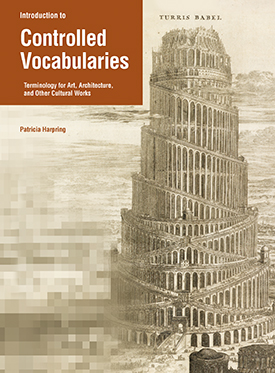
Introduction to Controlled Vocabularies: Terminologies for Art, Architecture, and Other Cultural Works
Patricia Harpring, with a foreword by Murtha Baca
2010
258 pages
PDF file size: 29.9 MB
Description
This detailed book is a “how-to” guide to building controlled vocabulary tools, cataloging and indexing cultural materials with terms and names from controlled vocabularies, and using vocabularies in search engines and databases to enhance discovery and retrieval online.
Also covered are the following: What are controlled vocabularies and why are they useful? Which vocabularies exist for cataloging art and cultural objects? How should they be integrated in a cataloging system? How should they be used for indexing and for retrieval? How should an institution construct a local authority file? The links in a controlled vocabulary ensure that relationships are defined and maintained for both cataloging and retrieval, clarifying whether a rose window and a Catherine wheel are the same thing, or how pot-metal glass is related to the more general term stained glass. The book provides organizations and individuals with a practical tool for creating and implementing vocabularies as reference tools, sources of documentation, and powerful enhancements for online searching.
Table of Contents
- Foreword
- Acknowledgments
- 1. Controlled Vocabularies in Context
- 2. What Are Controlled Vocabularies?
- 3. Relationships in Controlled Vocabularies
- 4. Vocabularies for Cultural Objects
- 5. Using Multiple Vocabularies
- 6. Local Authorities
- 7. Constructing a Vocabulary or Authority
- 8. Indexing with Controlled Vocabularies
- 9. Retrieval Using Controlled Vocabularies
- Appendix: Selected Vocabularies and Other Sources for Terminology
- Glossary
- Selected Bibliography
About the Authors
Patricia Harpring is managing editor of the Vocabulary Program at the Getty Research Institute.
Murtha Baca is Head of Digital Art Historical Access at the Getty Research Institute.
Press Reviews and Awards
- “This work will be illuminating to anyone seeking an understanding of the construction and use of controlled vocabularies.” —Art Libraries Society of North America Reviews
- “A welcome addition to the small collection of books on controlled vocabularies.” —Key Words